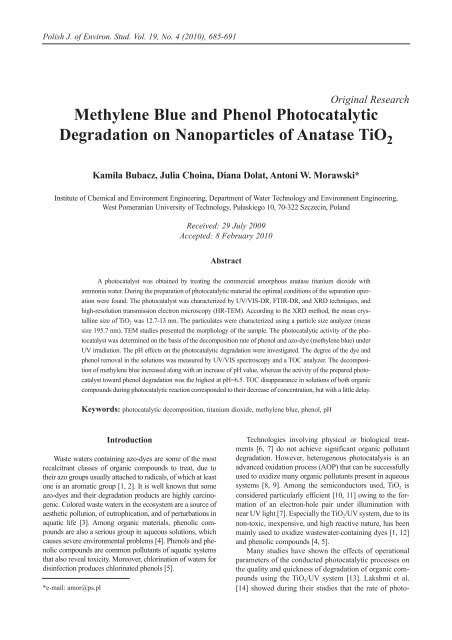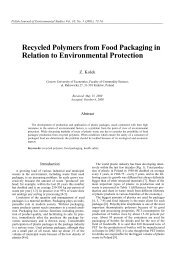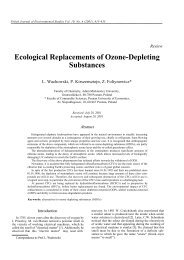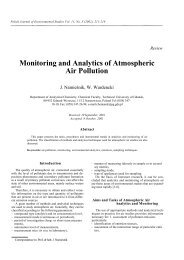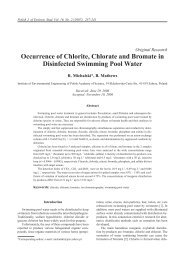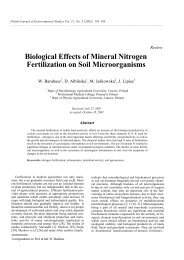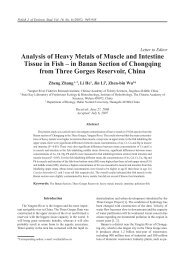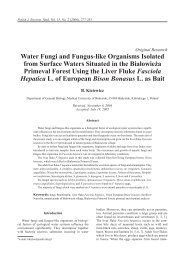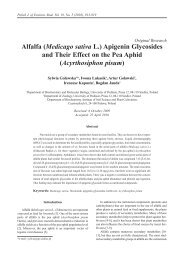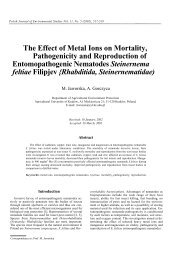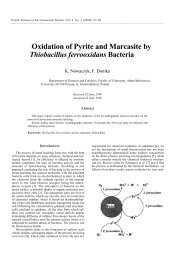Methylene Blue and Phenol Photocatalytic Degradation on ...
Methylene Blue and Phenol Photocatalytic Degradation on ...
Methylene Blue and Phenol Photocatalytic Degradation on ...
You also want an ePaper? Increase the reach of your titles
YUMPU automatically turns print PDFs into web optimized ePapers that Google loves.
Polish J. of Envir<strong>on</strong>. Stud. Vol. 19, No. 4 (2010), 685-691<br />
Original Research<br />
<str<strong>on</strong>g>Methylene</str<strong>on</strong>g> <str<strong>on</strong>g>Blue</str<strong>on</strong>g> <str<strong>on</strong>g>and</str<strong>on</strong>g> <str<strong>on</strong>g>Phenol</str<strong>on</strong>g> <str<strong>on</strong>g>Photocatalytic</str<strong>on</strong>g><br />
<str<strong>on</strong>g>Degradati<strong>on</strong></str<strong>on</strong>g> <strong>on</strong> Nanoparticles of Anatase TiO 2<br />
Kamila Bubacz, Julia Choina, Diana Dolat, Ant<strong>on</strong>i W. Morawski*<br />
Institute of Chemical <str<strong>on</strong>g>and</str<strong>on</strong>g> Envir<strong>on</strong>ment Engineering, Department of Water Technology <str<strong>on</strong>g>and</str<strong>on</strong>g> Envir<strong>on</strong>ment Engineering,<br />
West Pomeranian University of Technology, Pułaskiego 10, 70-322 Szczecin, Pol<str<strong>on</strong>g>and</str<strong>on</strong>g><br />
Received: 29 July 2009<br />
Accepted: 8 February 2010<br />
Abstract<br />
A photocatalyst was obtained by treating the commercial amorphous anatase titanium dioxide with<br />
amm<strong>on</strong>ia water. During the preparati<strong>on</strong> of photocatalytic material the optimal c<strong>on</strong>diti<strong>on</strong>s of the separati<strong>on</strong> operati<strong>on</strong><br />
were found. The photocatalyst was characterized by UV/VIS-DR, FTIR-DR, <str<strong>on</strong>g>and</str<strong>on</strong>g> XRD techniques, <str<strong>on</strong>g>and</str<strong>on</strong>g><br />
high-resoluti<strong>on</strong> transmissi<strong>on</strong> electr<strong>on</strong> microscopy (HR-TEM). According to the XRD method, the mean crystalline<br />
size of TiO 2 was 12.7-13 nm. The particulates were characterized using a particle size analyzer (mean<br />
size 195.7 nm). TEM studies presented the morphology of the sample. The photocatalytic activity of the photocatalyst<br />
was determined <strong>on</strong> the basis of the decompositi<strong>on</strong> rate of phenol <str<strong>on</strong>g>and</str<strong>on</strong>g> azo-dye (methylene blue) under<br />
UV irradiati<strong>on</strong>. The pH effects <strong>on</strong> the photocatalytic degradati<strong>on</strong> were investigated. The degree of the dye <str<strong>on</strong>g>and</str<strong>on</strong>g><br />
phenol removal in the soluti<strong>on</strong>s was measured by UV/VIS spectroscopy <str<strong>on</strong>g>and</str<strong>on</strong>g> a TOC analyzer. The decompositi<strong>on</strong><br />
of methylene blue increased al<strong>on</strong>g with an increase of pH value, whereas the activity of the prepared photocatalyst<br />
toward phenol degradati<strong>on</strong> was the highest at pH=6.5. TOC disappearance in soluti<strong>on</strong>s of both organic<br />
compounds during photocatalytic reacti<strong>on</strong> corresp<strong>on</strong>ded to their decrease of c<strong>on</strong>centrati<strong>on</strong>, but with a little delay.<br />
Keywords: photocatalytic decompositi<strong>on</strong>, titanium dioxide, methylene blue, phenol, pH<br />
Introducti<strong>on</strong><br />
Waste waters c<strong>on</strong>taining azo-dyes are some of the most<br />
recalcitrant classes of organic compounds to treat, due to<br />
their azo groups usually attached to radicals, of which at least<br />
<strong>on</strong>e is an aromatic group [1, 2]. It is well known that some<br />
azo-dyes <str<strong>on</strong>g>and</str<strong>on</strong>g> their degradati<strong>on</strong> products are highly carcinogenic.<br />
Colored waste waters in the ecosystem are a source of<br />
aesthetic polluti<strong>on</strong>, of eutrophicati<strong>on</strong>, <str<strong>on</strong>g>and</str<strong>on</strong>g> of perturbati<strong>on</strong>s in<br />
aquatic life [3]. Am<strong>on</strong>g organic materials, phenolic compounds<br />
are also a serious group in aqueous soluti<strong>on</strong>s, which<br />
causes severe envir<strong>on</strong>mental problems [4]. <str<strong>on</strong>g>Phenol</str<strong>on</strong>g>s <str<strong>on</strong>g>and</str<strong>on</strong>g> phenolic<br />
compounds are comm<strong>on</strong> pollutants of aquatic systems<br />
that also reveal toxicity. Moreover, chlorinati<strong>on</strong> of waters for<br />
disinfecti<strong>on</strong> produces chlorinated phenols [5].<br />
*e-mail: amor@ps.pl<br />
Technologies involving physical or biological treatments<br />
[6, 7] do not achieve significant organic pollutant<br />
degradati<strong>on</strong>. However, heterogenous photocatalysis is an<br />
advanced oxidati<strong>on</strong> process (AOP) that can be successfully<br />
used to oxidize many organic pollutants present in aqueous<br />
systems [8, 9]. Am<strong>on</strong>g the semic<strong>on</strong>ductors used, TiO 2 is<br />
c<strong>on</strong>sidered particularly efficient [10, 11] owing to the formati<strong>on</strong><br />
of an electr<strong>on</strong>-hole pair under illuminati<strong>on</strong> with<br />
near UV light [7]. Especially the TiO 2 /UV system, due to its<br />
n<strong>on</strong>-toxic, inexpensive, <str<strong>on</strong>g>and</str<strong>on</strong>g> high reactive nature, has been<br />
mainly used to oxidize wastewater-c<strong>on</strong>taining dyes [1, 12]<br />
<str<strong>on</strong>g>and</str<strong>on</strong>g> phenolic compounds [4, 5].<br />
Many studies have shown the effects of operati<strong>on</strong>al<br />
parameters of the c<strong>on</strong>ducted photocatalytic processes <strong>on</strong><br />
the quality <str<strong>on</strong>g>and</str<strong>on</strong>g> quickness of degradati<strong>on</strong> of organic compounds<br />
using the TiO 2 /UV system [13]. Lakshmi et al.<br />
[14] showed during their studies that the rate of photo-
686 Bubacz K., et al.<br />
catalytic reacti<strong>on</strong> increased with a rise of the amount of catalyst,<br />
<str<strong>on</strong>g>and</str<strong>on</strong>g> remained almost c<strong>on</strong>stant above a certain level.<br />
The influence of the initial c<strong>on</strong>centrati<strong>on</strong> of methylene blue<br />
<strong>on</strong> decolorizati<strong>on</strong> time was observed. While c<strong>on</strong>ducting<br />
many photocatalytic processes, dependence indicating an<br />
increased rate of dye degradati<strong>on</strong> al<strong>on</strong>g with an increase in<br />
the compound c<strong>on</strong>centrati<strong>on</strong> to a certain level was found.<br />
But in case of phenol, Chiou et al. [4] indicated that photocatalytic<br />
oxidati<strong>on</strong> is rather promising at low organic pollutant<br />
c<strong>on</strong>centrati<strong>on</strong>s. Tang et al. [1] also raised str<strong>on</strong>g dependence<br />
treatment efficiency up<strong>on</strong> wavelength, light intensity,<br />
<str<strong>on</strong>g>and</str<strong>on</strong>g> the molecular structure of compounds.<br />
According to Wang et al. [15], <strong>on</strong>e of the most important<br />
parameters having an effect <strong>on</strong> pollutant degradati<strong>on</strong> is<br />
the pH value of a soluti<strong>on</strong>. They found that the decompositi<strong>on</strong><br />
of phenol in the TiO 2 /UV process str<strong>on</strong>gly indicated<br />
pH influence <strong>on</strong> such properties as semic<strong>on</strong>ductor surface<br />
charge state, flat b<str<strong>on</strong>g>and</str<strong>on</strong>g> potential, <str<strong>on</strong>g>and</str<strong>on</strong>g> dissociati<strong>on</strong> of the<br />
soluti<strong>on</strong> [4]. Many dyes have negatively charged groups in<br />
their structures, <str<strong>on</strong>g>and</str<strong>on</strong>g> in acidic soluti<strong>on</strong>s str<strong>on</strong>g adsorpti<strong>on</strong> of<br />
dyes <strong>on</strong>to photocatalyst surface improving decompositi<strong>on</strong><br />
of these pollutants does take place. This behavior in literature<br />
described elsewhere [16] is due to the amphoteric properties<br />
of TiO 2 particles. Since methylene blue is a cati<strong>on</strong>ic<br />
dye, its adsorpti<strong>on</strong> <strong>on</strong> TiO 2 surface <str<strong>on</strong>g>and</str<strong>on</strong>g> decompositi<strong>on</strong> are<br />
favored at high pH values, which was put forward by<br />
Guillard et al. [17]. The present study also shows that there<br />
is a high probability that the degradati<strong>on</strong> of substrates<br />
occurs <strong>on</strong> the surface of the photocatalyst.<br />
The use of TiO 2 particles as a photocatalyst for the initiati<strong>on</strong><br />
of redox chemical reacti<strong>on</strong>s <str<strong>on</strong>g>and</str<strong>on</strong>g> finding their best<br />
c<strong>on</strong>diti<strong>on</strong> are c<strong>on</strong>tinuously an active area of investigati<strong>on</strong>s.<br />
In the present paper, we report photodegradati<strong>on</strong> of methylene<br />
blue <str<strong>on</strong>g>and</str<strong>on</strong>g> phenol <strong>on</strong> prepared TiO 2 in tests under UV<br />
irradiati<strong>on</strong>. In this work, we also carried out characterizati<strong>on</strong><br />
of prepared TiO 2 <str<strong>on</strong>g>and</str<strong>on</strong>g> described the influence of pH of<br />
soluti<strong>on</strong>s <strong>on</strong> the degree of organic compounds decompositi<strong>on</strong>.<br />
Experimental<br />
Materials<br />
The commercial amorphous anatase titanium dioxide<br />
was used as a base material. The photocatalyst was supplied<br />
by the Police Chemical Factory in Pol<str<strong>on</strong>g>and</str<strong>on</strong>g>.<br />
Azo-dye (methylene blue), produced by the Boruta-<br />
Color Company (Pol<str<strong>on</strong>g>and</str<strong>on</strong>g>) <str<strong>on</strong>g>and</str<strong>on</strong>g> phenol were used as model<br />
organic compounds for photocatalytic tests.<br />
Preparati<strong>on</strong> of the Photocatalyst<br />
Crude commercial amorphous anatase titanium dioxide<br />
shows a str<strong>on</strong>g acid reacti<strong>on</strong> (1.3-2.0). Therefore, the investigated<br />
material was washed with amm<strong>on</strong>ia water in order to<br />
neutralize acid reacti<strong>on</strong>. Then it was washed off several times<br />
with distilled water in order to remove sulphate i<strong>on</strong>s <str<strong>on</strong>g>and</str<strong>on</strong>g> an<br />
excess of amm<strong>on</strong>ia. The following step was the separati<strong>on</strong> of<br />
titanium dioxide particles from water soluti<strong>on</strong>. Subsequently,<br />
TiO 2 was dried at 80ºC for a few hours. Finally, the photocatalyst<br />
obtained was ground with a mortar.<br />
H 2 SO 4 was added into a little part of the photocatalyst<br />
obtained in this way in order to instantaneously neutralize<br />
alkali reacti<strong>on</strong> caused by the excess of amm<strong>on</strong>ia water. Two<br />
TiO 2 samples with <str<strong>on</strong>g>and</str<strong>on</strong>g> without the additi<strong>on</strong> of H 2 SO 4 were<br />
tested using the methods described below.<br />
Characterizati<strong>on</strong> of the Photocatalyst<br />
The photocatalyst sample has been characterized by<br />
UV-VIS/DR using a spectrophotometer (Jasco, Japan)<br />
equipped with an integrating sphere accessory for diffuse<br />
reflectance spectra, where BaSO 4 was used as a reference.<br />
The spectra as well as b<str<strong>on</strong>g>and</str<strong>on</strong>g> gap energy calculati<strong>on</strong>s were<br />
performed using Jasco procedure c<strong>on</strong>tained in the Jasco<br />
computer program.<br />
The surface properties of the photocatalyst were recorded<br />
<strong>on</strong> the basis of FTIR/DRS spectra. The measurements<br />
were performed using an FTIR spectrometer (Jasco, Japan)<br />
equipped with a diffuse reflectance accessory from the<br />
Harrick Company (USA).<br />
The photocatalyst sample has also been characterized<br />
by XRD technique using X’Pert PRO Philips diffractometer.<br />
The mean size of crystallites <str<strong>on</strong>g>and</str<strong>on</strong>g> the participati<strong>on</strong> of<br />
TiO 2 phases was measured.<br />
The particle size of the photocatalyst was measured<br />
with a Zetasizer Nano-ZS manufactured by the Malvern<br />
Company.<br />
The morphology of the sample was also studied via an<br />
FEI Tecnai F30 high resoluti<strong>on</strong> transmissi<strong>on</strong> electr<strong>on</strong><br />
microscope.<br />
<str<strong>on</strong>g>Photocatalytic</str<strong>on</strong>g> Decompositi<strong>on</strong><br />
The photocatalytic activity of the prepared TiO 2 was<br />
analyzed by photocatalytic decompositi<strong>on</strong> of phenol <str<strong>on</strong>g>and</str<strong>on</strong>g><br />
methylene blue. The reacti<strong>on</strong>s were carried out in a glass<br />
batch photoreactor c<strong>on</strong>taining 500 cm 3 of a soluti<strong>on</strong> <str<strong>on</strong>g>and</str<strong>on</strong>g> 0.1<br />
g of the photocatalyst. Aqueous soluti<strong>on</strong>s of phenol <str<strong>on</strong>g>and</str<strong>on</strong>g><br />
methylene blue were used with c<strong>on</strong>centrati<strong>on</strong>s of 50 mg/l<br />
<str<strong>on</strong>g>and</str<strong>on</strong>g> 10 mg/l, respectively. Aqueous suspensi<strong>on</strong>s of TiO 2<br />
c<strong>on</strong>taining phenol or methylene blue (under c<strong>on</strong>stant magnetic<br />
stirring) were irradiated for different intervals of time.<br />
Irradiati<strong>on</strong> of the soluti<strong>on</strong>s was performed under UV-Vis<br />
light (6 lamps with power of 20 W, Philips) with a radiati<strong>on</strong><br />
intensity of approximately 166.65 W/m 2 for Vis <str<strong>on</strong>g>and</str<strong>on</strong>g><br />
182.873 W/m 2 for UV. The c<strong>on</strong>centrati<strong>on</strong> of the dye <str<strong>on</strong>g>and</str<strong>on</strong>g><br />
phenol was m<strong>on</strong>itored by measuring the absorbance of the<br />
samples using a UV-Vis spectrometer (Jasco, Japan). The<br />
c<strong>on</strong>centrati<strong>on</strong>s in the soluti<strong>on</strong>s were calculated by a computer<br />
program based <strong>on</strong> the calibrati<strong>on</strong> curve. The program<br />
determines the absorbance of a soluti<strong>on</strong> at the maximum<br />
wavelengths of the investigated organic compounds. The<br />
progress of the reacti<strong>on</strong> was followed by m<strong>on</strong>itoring the<br />
disappearance of the methylene blue at 664 nm <str<strong>on</strong>g>and</str<strong>on</strong>g> the phenol<br />
at 270 nm. In order to evaluate the mineralizati<strong>on</strong> of
<str<strong>on</strong>g>Methylene</str<strong>on</strong>g> <str<strong>on</strong>g>Blue</str<strong>on</strong>g> <str<strong>on</strong>g>and</str<strong>on</strong>g> <str<strong>on</strong>g>Phenol</str<strong>on</strong>g> <str<strong>on</strong>g>Photocatalytic</str<strong>on</strong>g>... 687<br />
chemical substances, the total organic carb<strong>on</strong> (TOC) of the<br />
samples was also analyzed with a multi N/C 2000 Analytic<br />
Jena analyzer.<br />
The photocatalytic degradati<strong>on</strong>s of phenol <str<strong>on</strong>g>and</str<strong>on</strong>g> methylene<br />
blue were carried out at different pHs. The pH of the<br />
soluti<strong>on</strong>s was adjusted with a Seven Multi Mettler Toledo<br />
using NaOH or HCl.<br />
Results <str<strong>on</strong>g>and</str<strong>on</strong>g> Discussi<strong>on</strong><br />
The operati<strong>on</strong> of separati<strong>on</strong> was important to our study.<br />
After washing with amm<strong>on</strong>ia water <str<strong>on</strong>g>and</str<strong>on</strong>g> several times with<br />
distilled water the photocatalyst should be separated from<br />
the water soluti<strong>on</strong>. Such TiO 2 has a negative pzc. An additi<strong>on</strong><br />
of an acid soluti<strong>on</strong>, i.e. H 2 SO 4 in our case, to titania<br />
washed off with amm<strong>on</strong>ia water, enabled us to find zeta<br />
potential of the prepared TiO 2 equal to zero. Zeta potential<br />
is a potential difference between the absorbing layer <str<strong>on</strong>g>and</str<strong>on</strong>g><br />
diffuse layer [18]. When the zeta potential equals zero, TiO 2<br />
particles do not have any interacti<strong>on</strong>. The important feature<br />
is the fact that pH affects the zeta potential. In the present<br />
experiments it was shown that the zeta potential of the studied<br />
TiO 2 is equal to zero at pH=6.8. At this zero point of<br />
charge the sedimentati<strong>on</strong> of the photocatalyst proceeded<br />
quickly <str<strong>on</strong>g>and</str<strong>on</strong>g> precisely.<br />
The UV-VIS/DR spectra of a crude photocatalyst after<br />
treatment with NH 3aq , as well as the TiO 2 after an additi<strong>on</strong><br />
of H 2 SO 4 , are presented in Fig. 1. For both photocatalysts<br />
prepared for this study there is <strong>on</strong>e absorpti<strong>on</strong> edge in the<br />
UV regi<strong>on</strong> (of λ=370 nm, E g =3.351 eV for the catalyst after<br />
treatment with NH 3aq <strong>on</strong>ly <str<strong>on</strong>g>and</str<strong>on</strong>g> of λ=374 nm, E g =3.315 eV<br />
for the catalyst after the additi<strong>on</strong> of H 2 SO 4 ). From the presence<br />
of the UV absorpti<strong>on</strong> edge it can be supposed that the<br />
catalyst should be active under UV light illuminati<strong>on</strong> <strong>on</strong>ly.<br />
The character of UV-VIS/DR spectra <str<strong>on</strong>g>and</str<strong>on</strong>g> the b<str<strong>on</strong>g>and</str<strong>on</strong>g>-gap<br />
energy of both samples of the photocatalyst are nearly the<br />
same. An additi<strong>on</strong> of H 2 SO 4 during the preparati<strong>on</strong> of the<br />
photocatalyst has no influence <strong>on</strong> UV-VIS-DR spectra or<br />
<strong>on</strong> any b<str<strong>on</strong>g>and</str<strong>on</strong>g>-gap energy of the photocatalyst.<br />
FTIR spectroscopy was used to analyze the prepared<br />
photocatalyst. FTIR patterns of both samples of the photocatalyst,<br />
TiO 2 after treatment with NH 3aq , <str<strong>on</strong>g>and</str<strong>on</strong>g> the same after<br />
the additi<strong>on</strong> of H 2 SO 4 are shown in Fig. 2. In the case of<br />
both samples, absorpti<strong>on</strong> b<str<strong>on</strong>g>and</str<strong>on</strong>g>s appeared <strong>on</strong> the absorpti<strong>on</strong><br />
spectra in the range of 3,300-3,500 cm -1 . The fact that these<br />
b<str<strong>on</strong>g>and</str<strong>on</strong>g>s are to be found is due to the presence of adsorbed<br />
water <str<strong>on</strong>g>and</str<strong>on</strong>g> hydroxyl groups [19]. The b<str<strong>on</strong>g>and</str<strong>on</strong>g>s can also be<br />
observed in both spectra of 1,630-1,640 cm -1 . It can be<br />
assigned to molecular water-b<str<strong>on</strong>g>and</str<strong>on</strong>g>ing mode [19, 20]. It is<br />
possible to observe insignificant b<str<strong>on</strong>g>and</str<strong>on</strong>g>s in the range of<br />
2,400 cm -1 . This fact is caused by the presence of CO 2 during<br />
the preparati<strong>on</strong> of these samples. According to Ihara et<br />
al. [21] the exhibiti<strong>on</strong> b<str<strong>on</strong>g>and</str<strong>on</strong>g>s at ca. 1,430-1,440 cm -1 could<br />
be attributed to bending vibrati<strong>on</strong>s of NH 4+ . It can be supposed<br />
that the spectra of TiO 2 treated with NH 3aq could<br />
exhibit some b<str<strong>on</strong>g>and</str<strong>on</strong>g>s in this range. However, in both discussed<br />
samples b<str<strong>on</strong>g>and</str<strong>on</strong>g>s in the spectra with a maximum at ca.<br />
1,430-1,440 cm -1 were not observed. An absence of the menti<strong>on</strong>ed<br />
b<str<strong>on</strong>g>and</str<strong>on</strong>g>s could be explained by a properly c<strong>on</strong>ducted<br />
process of photocatalyst preparati<strong>on</strong> <str<strong>on</strong>g>and</str<strong>on</strong>g> by precise washing<br />
of the excess of amm<strong>on</strong>ia. In c<strong>on</strong>clusi<strong>on</strong>, NH 4+ i<strong>on</strong> was not<br />
inbuilt into the surface of the photocatalyst. Hadjiivanov [22]<br />
observed a drastic absorbance increase below 1,000 cm -1 due<br />
to the self-adsorpti<strong>on</strong> of rutile. As shown below (X-ray<br />
powder diffracti<strong>on</strong>), a small amount of a crystal phase of<br />
rutile was present in the investigated photocatalyst.<br />
a)<br />
b)<br />
Wavelenght [nm]<br />
Wavelenght [nm]<br />
Fig. 1. (a) UV-Vis/DR reflecti<strong>on</strong> spectra of the photocatalysts:<br />
with NH 3aq <strong>on</strong>ly (1) <str<strong>on</strong>g>and</str<strong>on</strong>g> with H 2 SO 4 in additi<strong>on</strong> (2), respectively,<br />
(b) The first derivative of UV-Vis/DR absorpti<strong>on</strong> spectra<br />
of photocatalysts.<br />
Abs<br />
4<br />
3<br />
2<br />
1<br />
0<br />
5,000 4,000, 3,000 2,000 1,000 600<br />
Wavenumber [cm -1 ]<br />
Fig. 2. The FTIR/DRS spectra of photocatalysts: with NH 3aq<br />
<strong>on</strong>ly (1) <str<strong>on</strong>g>and</str<strong>on</strong>g> with H 2 SO 4 in additi<strong>on</strong> (2), respectively.
688 Bubacz K., et al.<br />
Therefore, some b<str<strong>on</strong>g>and</str<strong>on</strong>g>s with a high intensity in the low-frequency<br />
were detected. The spectra of both samples are<br />
nearly the same. This indicates that an additi<strong>on</strong> of H 2 SO 4<br />
during preparati<strong>on</strong> of the photocatalyst in order to improve<br />
the operati<strong>on</strong> of sedimentati<strong>on</strong> does not influence the surface<br />
properties of TiO 2 photocatalyst.<br />
The powder X-ray diffracti<strong>on</strong> patterns of TiO 2 after<br />
treatment with NH 3aq were taken using the diffractometer,<br />
where the X-ray source was CoK α radiati<strong>on</strong>. The pattern<br />
was collected in the range of 26-34º 2θ with a scan step of<br />
0.02 in a c<strong>on</strong>tinuous scan mode. The mean size of crystallites<br />
was calculated from the line broadening corresp<strong>on</strong>ding<br />
X-ray diffracti<strong>on</strong> peaks, according to the Sherrer equati<strong>on</strong>:<br />
D = λ / β cosθ<br />
...where D is the crystallite size, λ is the wavelength of X-<br />
ray radiati<strong>on</strong> (CoK α radiati<strong>on</strong>, λ=0.17889 nm), β is line<br />
width at medium height, <str<strong>on</strong>g>and</str<strong>on</strong>g> θ is the diffracti<strong>on</strong> peak<br />
angle. In order to find β, the full-width of the peak was calculated<br />
at half maxima of X-ray diffracti<strong>on</strong> peaks. The<br />
results were obtained after the instrument was corrected.<br />
The mean crystallite size of the researched photocatalyst<br />
calculated from the discussed method increases to 12.7-13<br />
nm.<br />
Fig. 3 shows the diffractogram of the photocatalyst. It<br />
can be seen from the pattern that the prepared titanium dioxide<br />
exhibits diffracti<strong>on</strong> lines of anatase phase. It was<br />
observed using XRD technique that the researched TiO 2 was<br />
not completely crystallized, but it c<strong>on</strong>sisted of crystalline<br />
(anatase <str<strong>on</strong>g>and</str<strong>on</strong>g> rutile) <str<strong>on</strong>g>and</str<strong>on</strong>g> amorphous fracti<strong>on</strong>s of titanium<br />
dioxide. Amounts of three forms of TiO 2 in the sample were<br />
calculated according to the following three equati<strong>on</strong>s:<br />
R<br />
R<br />
R<br />
A<br />
R<br />
am<br />
<br />
<br />
I 100<br />
A<br />
(%)<br />
I I 1.242<br />
A R<br />
1,242 I 100<br />
R<br />
I<br />
I 1.424 (%)<br />
A R<br />
100 [ R (%) <br />
A<br />
(%) R<br />
(%)]<br />
...where R A , R R , R am are c<strong>on</strong>tents of anatase, rutile, <str<strong>on</strong>g>and</str<strong>on</strong>g><br />
amorphous phase, respectively. I A <str<strong>on</strong>g>and</str<strong>on</strong>g> I R are peak intensities<br />
of anatase <str<strong>on</strong>g>and</str<strong>on</strong>g> rutile.<br />
The results obtained show that the values of the phases<br />
c<strong>on</strong>tained in the TiO 2 were equal to 35% of anatase, 3.5%<br />
of rutile, <str<strong>on</strong>g>and</str<strong>on</strong>g> 61.5% of amorphous phase.<br />
Particle size distributi<strong>on</strong> for the TiO 2 suspensi<strong>on</strong> is presented<br />
in Fig. 4a. The presented results were estimated <strong>on</strong><br />
the basis of intensity according to the calculati<strong>on</strong>s c<strong>on</strong>tained<br />
in the computer program. The particles’ size distributi<strong>on</strong><br />
can also tell about the stability of the suspensi<strong>on</strong> that<br />
is shown in Fig. 4b. The resulting mean particle size of the<br />
photocatalyst was 197.5 nm.<br />
The transmissi<strong>on</strong> electr<strong>on</strong> microscopy analysis of the<br />
prepared photocatalyst indicated the presence of a nanomaterial<br />
shown in Fig. 5. The sample is formed by the small<br />
R<br />
crystalline phases embedded into the amorphous structure.<br />
The grains of the sample exhibit a regular round shape.<br />
These observati<strong>on</strong>s of the sample are in full agreement with<br />
the above-described XRD results.<br />
The role of pH <strong>on</strong> the rate of photocatalytic degradati<strong>on</strong><br />
in soluti<strong>on</strong>s of phenol <str<strong>on</strong>g>and</str<strong>on</strong>g> methylene blue was studied. The<br />
effect of pH <strong>on</strong> the decompositi<strong>on</strong> of these two organic<br />
compounds was summarized in Figs. 6 <str<strong>on</strong>g>and</str<strong>on</strong>g> 7, <str<strong>on</strong>g>and</str<strong>on</strong>g> pH was<br />
examined as <strong>on</strong>e of the most important factors that can<br />
affect photo-oxidati<strong>on</strong> processes. In order to check the<br />
degree of the photocatalytic degradati<strong>on</strong> of phenol <str<strong>on</strong>g>and</str<strong>on</strong>g><br />
methylene blue in soluti<strong>on</strong>s in different c<strong>on</strong>diti<strong>on</strong>s, the percentage<br />
of decompositi<strong>on</strong> during UV irradiati<strong>on</strong> was analyzed.<br />
The best results in case of soluti<strong>on</strong>s of phenol were<br />
obtained at pH=6.5. After 6 h of illuminati<strong>on</strong> 35.18% of dye<br />
counts<br />
12,000<br />
10,000<br />
8,000<br />
6,000<br />
4,000<br />
2,000<br />
0<br />
26 27 28 29 30 31 32 33 34<br />
positi<strong>on</strong> [2]<br />
Fig. 3. The XRD pattern of photocatalyst washed off with<br />
amm<strong>on</strong>ia water in the range 26-34º.<br />
Correlati<strong>on</strong> coefficient Intensity (%)<br />
a)<br />
b)<br />
Size (d.nm)<br />
Time (µs)<br />
Fig. 4. (a) Size distributi<strong>on</strong> by intensity of the TiO 2 in suspensi<strong>on</strong>,<br />
(b) raw correlati<strong>on</strong> date.
<str<strong>on</strong>g>Methylene</str<strong>on</strong>g> <str<strong>on</strong>g>Blue</str<strong>on</strong>g> <str<strong>on</strong>g>and</str<strong>on</strong>g> <str<strong>on</strong>g>Phenol</str<strong>on</strong>g> <str<strong>on</strong>g>Photocatalytic</str<strong>on</strong>g>... 689<br />
Fig. 5. TEM images of the prepared TiO 2 photocatalyst.<br />
was removed. Nevertheless, after 14 h of irradiati<strong>on</strong> this<br />
degree reached 60.55%. At the same time, others carried<br />
out experiments achieving 54.01%, 48.05%, <str<strong>on</strong>g>and</str<strong>on</strong>g> 39.95% of<br />
removal for soluti<strong>on</strong>s of phenol at pH=9, 3, <str<strong>on</strong>g>and</str<strong>on</strong>g> 7.2, respectively.<br />
A decrease of methylene blue c<strong>on</strong>centrati<strong>on</strong> in the<br />
three c<strong>on</strong>ducted experiments at different c<strong>on</strong>diti<strong>on</strong>s was<br />
observed. In the soluti<strong>on</strong>s of dye the influence of pH <strong>on</strong> the<br />
degree of dye decolorati<strong>on</strong> in a decreasing order is as follows:<br />
pH=9 > pH=5.8 > pH=3. It is clear that the highest<br />
degree of photocatalytic degradati<strong>on</strong> of methylene blue<br />
gave the basic soluti<strong>on</strong> (above 96% after 6 h of UV radiati<strong>on</strong>).<br />
The difference of the degree of the decompositi<strong>on</strong> in<br />
basic soluti<strong>on</strong>s in comparis<strong>on</strong> with acidic soluti<strong>on</strong>s appeared<br />
to be significant. Removal of the described organic dye in<br />
the same period of time amounted to 50.05% for a soluti<strong>on</strong><br />
at pH=5.8 <str<strong>on</strong>g>and</str<strong>on</strong>g> 48.56% for that at pH=3. After 10 h of illuminati<strong>on</strong><br />
with UV light, the amount of dye that underwent<br />
decompositi<strong>on</strong> reached 100%. These measurements dem<strong>on</strong>strate<br />
that methylene blue can be completely decolorized at<br />
basic pH during 10 h UV irradiati<strong>on</strong> using the prepared<br />
TiO 2 . The photocatalyst showed the stability of its activity<br />
during multiple experiments (date not presented here). In<br />
the presented study, an increase in the rate of the photocatalytic<br />
degradati<strong>on</strong> with an increase in pH was observed.<br />
removal of phenol [%]<br />
a)<br />
40<br />
35<br />
30<br />
25<br />
20<br />
15<br />
10 10<br />
5<br />
0<br />
%removal ovalaccording according to to Abs Abs<br />
%removal ovalaccording according to to TO TOC C<br />
3 6,5 7,2 9<br />
6,5 7,2 pH value<br />
pH value<br />
removal of methylene blue [%]<br />
a)<br />
120<br />
100<br />
80<br />
60<br />
40<br />
20<br />
0<br />
%removal according to Abs<br />
%removal according to TOC<br />
3 5,8 9<br />
pH value<br />
b)<br />
b)<br />
removal of phenol [%]<br />
70<br />
60<br />
50<br />
40<br />
30<br />
20<br />
10<br />
0<br />
%removal according to Abs<br />
%removal according to TOC<br />
3 6,5 7,2 9<br />
pH value<br />
Fig. 6. <str<strong>on</strong>g>Photocatalytic</str<strong>on</strong>g> removal of phenol in the presence of<br />
TiO 2 : (a) after 6 h UV radiati<strong>on</strong>, (b) after 14 h UV radiati<strong>on</strong>.<br />
Experimental c<strong>on</strong>diti<strong>on</strong>s: initial phenol c<strong>on</strong>centrati<strong>on</strong> 50 mg/dm 3 ,<br />
catalyst c<strong>on</strong>tent 0.2 g/dm 3 .<br />
removal of methylene blue [%]<br />
120<br />
100<br />
80<br />
60<br />
40<br />
20<br />
0<br />
%removal according to Abs<br />
%removal according to TOC<br />
3 5,8 9<br />
pH value<br />
Fig. 7. <str<strong>on</strong>g>Photocatalytic</str<strong>on</strong>g> removal of methylene blue in the presence<br />
of TiO 2 : (a) after 6 h UV radiati<strong>on</strong>, (b) after 10 h UV radiati<strong>on</strong>.<br />
Experimental c<strong>on</strong>diti<strong>on</strong>s: initial dye c<strong>on</strong>centrati<strong>on</strong> 10<br />
mg/dm 3 , catalyst c<strong>on</strong>tent 0.2 g/dm 3 .
690 Bubacz K., et al.<br />
Our results corresp<strong>on</strong>ded with an observati<strong>on</strong> that has been<br />
made by other authors. According to Ling [23], basic pH<br />
electrostatic interacti<strong>on</strong>s between negative TiO¯ <str<strong>on</strong>g>and</str<strong>on</strong>g> methylene<br />
blue cati<strong>on</strong> leads to a str<strong>on</strong>g adsorpti<strong>on</strong> with a corresp<strong>on</strong>ding<br />
high rate of degradati<strong>on</strong>. Here it should be c<strong>on</strong>cluded<br />
that pH affects the adsorpti<strong>on</strong> properties of organic<br />
compounds <str<strong>on</strong>g>and</str<strong>on</strong>g> their dissociating state in a soluti<strong>on</strong>. The<br />
surface charge properties of TiO 2 also changed with the<br />
changes of pH value due to the amphoteric behaviour of<br />
semi c<strong>on</strong>ducting TiO 2 [7, 16, 17, 23, 24].<br />
In Figs. 6 <str<strong>on</strong>g>and</str<strong>on</strong>g> 7 the removal of TOC in soluti<strong>on</strong>s of phenol<br />
<str<strong>on</strong>g>and</str<strong>on</strong>g> methylene blue at different pH during an illuminati<strong>on</strong><br />
period was presented as well. In the case of phenol<br />
soluti<strong>on</strong> after 6 h of irradiati<strong>on</strong> at pH=6.5, the percentage of<br />
photocatalytic decompositi<strong>on</strong> of phenol in aqueous TiO 2<br />
suspensi<strong>on</strong> was the highest, but the removal of TOC <strong>on</strong>ly<br />
reached 5.87%. It was the lowest result corresp<strong>on</strong>ding with<br />
soluti<strong>on</strong>s of phenol at other pH. TOC analysis shows degradati<strong>on</strong><br />
that leads to the c<strong>on</strong>versi<strong>on</strong> of organic compounds<br />
into harmless gaseous CO 2 <str<strong>on</strong>g>and</str<strong>on</strong>g> inorganic i<strong>on</strong>s [25]. After 6<br />
h of irradiati<strong>on</strong>, mineralizati<strong>on</strong> was not enough. However,<br />
the removal of TOC after an extensi<strong>on</strong> for a 14-h irradiati<strong>on</strong><br />
period at the same value of pH was almost 25%. The mineralizati<strong>on</strong>s<br />
for soluti<strong>on</strong>s at pH=3, 7.2, <str<strong>on</strong>g>and</str<strong>on</strong>g> 9 achieved<br />
25.19%, 28.87%, <str<strong>on</strong>g>and</str<strong>on</strong>g> 22.18%, respectively. The obtained<br />
results show that the mineralizati<strong>on</strong> of phenol does not<br />
immediately follow the degradati<strong>on</strong> of the soluti<strong>on</strong>. At the<br />
beginning, intermediates were present, which underwent<br />
further photocatalytic oxidati<strong>on</strong>. A decolorizati<strong>on</strong> of soluti<strong>on</strong>s<br />
of methylene blue also produced TOC disappearance.<br />
The photocatalytic degradati<strong>on</strong> of the analyzed dye<br />
reached, for example, given the natural pH equal to 5.8 <str<strong>on</strong>g>and</str<strong>on</strong>g><br />
after 6 h of irradiati<strong>on</strong> the removal of TOC amounting to<br />
3.99%. Then the soluti<strong>on</strong> was additi<strong>on</strong>ally illuminated for 4<br />
hours. At this time the extent of degradati<strong>on</strong> increased to<br />
28.29%. The tendency to later total organic carb<strong>on</strong> decrease<br />
in comparis<strong>on</strong> with c<strong>on</strong>centrati<strong>on</strong> of the organic compound<br />
was observed here as well.<br />
C<strong>on</strong>clusi<strong>on</strong>s<br />
In the present investigati<strong>on</strong>s, an industrial hydrolyzed<br />
TiOSO 4 was used as the precursor for preparati<strong>on</strong> of a photocatalyst<br />
after amm<strong>on</strong>ia treatment. During studying characterizati<strong>on</strong><br />
of the photocatalyst, the absence of nitrogen in<br />
TiO 2 structure was c<strong>on</strong>firmed by FTIR/DRS spectra of the<br />
titania. The prepared TiO 2 had photocatalytic efficiency<br />
under UV light <strong>on</strong>ly because of the presence of <strong>on</strong>e absorpti<strong>on</strong><br />
edge in the UV regi<strong>on</strong> according to UV-Vis/DR measurements.<br />
The mean particle size of the studied material<br />
was found to be 197.5 nm, while the average size of crystallites<br />
increased to 12.7-13 nm. The nanostructured material<br />
of the sample <str<strong>on</strong>g>and</str<strong>on</strong>g> the presence of amorphous <str<strong>on</strong>g>and</str<strong>on</strong>g> crystalline<br />
phases in the photocatalyst were revealed by TEM<br />
analysis as well. It was found that the pH value of the soluti<strong>on</strong><br />
str<strong>on</strong>gly influences the photocatalysis degradati<strong>on</strong> of<br />
organic compounds under UV radiati<strong>on</strong>. The photocatalytic<br />
decompositi<strong>on</strong> of phenol was most efficient at pH=6.5.<br />
However, in the case of applied methylene blue dye soluti<strong>on</strong><br />
high photocatalytic activity was preferred by basic<br />
reacti<strong>on</strong>. The mineralizati<strong>on</strong> of phenol <str<strong>on</strong>g>and</str<strong>on</strong>g> methylene blue<br />
measured by a level of TOC showed a similar tendency to<br />
remove organic compounds like UV-Vis spectrometry,<br />
which c<strong>on</strong>firms photocatalytic mineralizati<strong>on</strong> reacti<strong>on</strong>s<br />
c<strong>on</strong>ducted using the prepared TiO 2 .<br />
References<br />
1. TANG W. Z., AN H. UV/TiO 2 photocatalytic oxidati<strong>on</strong> of<br />
commercial dyes in aqueous soluti<strong>on</strong>s. Chemosphere 31,<br />
4157, 1995.<br />
2. MOHAPATRA P., PARIDA K.M. <str<strong>on</strong>g>Photocatalytic</str<strong>on</strong>g> activity of<br />
sulfate modified titania 3: Decolorizati<strong>on</strong> of methylene blue<br />
in aqueous soluti<strong>on</strong>. J. Mol. Catal. A: Chemical 258, 118,<br />
2006.<br />
3. LACHHEB H., PUZENAT E., HOUAS A., KSIBI M.,<br />
ELALOUI E., GUILLAND CH., HERRMANN J. M.<br />
<str<strong>on</strong>g>Photocatalytic</str<strong>on</strong>g> degradati<strong>on</strong> of various types of dyes (Alizarin<br />
S, Crocein Orange G, Methyl Red, C<strong>on</strong>go Red, <str<strong>on</strong>g>Methylene</str<strong>on</strong>g><br />
<str<strong>on</strong>g>Blue</str<strong>on</strong>g>) in water by UV-irradiated titania. Appl. Catal. B:<br />
Envir<strong>on</strong>mental 39, 75, 2002.<br />
4. CHIOU CH. H., WU CH. Y., JUANG R. S. Influence of<br />
operating parameters <strong>on</strong> photocatalytic degradati<strong>on</strong> of phenol<br />
in UV/TiO 2 process. Chem. Eng. J. 139, 322, 2008.<br />
5. AKBAL F., NUR ONAR A. <str<strong>on</strong>g>Photocatalytic</str<strong>on</strong>g> degradati<strong>on</strong> of<br />
phenol. Envir<strong>on</strong>. M<strong>on</strong>it. Asses. 83, 295, 2003.<br />
6. FORGACS E., CSERHÁTI T., OROS G. Removal of synthetic<br />
dyes from wastewaters: a review. Envir<strong>on</strong>. Int. 30,<br />
953, 2004.<br />
7. SENTHILKUMAAR S., PORKODI K., GOMATHI R.,<br />
MAHESWARI GEETHA A., MANONMANI N. Sol-gel<br />
derived silver doped nanocrystalline titania catalysed photodegradati<strong>on</strong><br />
of methylene blue from aqueous soluti<strong>on</strong>.<br />
Dyes <str<strong>on</strong>g>and</str<strong>on</strong>g> Pigments 69, 22, 2006.<br />
8. BIZANI E., FYTIANOS K., POULIOS I., TSIRIDIS V.<br />
<str<strong>on</strong>g>Photocatalytic</str<strong>on</strong>g> decolorizati<strong>on</strong> <str<strong>on</strong>g>and</str<strong>on</strong>g> degradati<strong>on</strong> of dye soluti<strong>on</strong>s<br />
<str<strong>on</strong>g>and</str<strong>on</strong>g> wastewaters in the presence of titanium dioxide. J.<br />
Hazard. Mater. 136, 85, 2006.<br />
9. HAJD SALAH N., BOUHELASSA M., BEKKOUCHE S.,<br />
BOULTIF A. Study of photocatalytic degradati<strong>on</strong> of phenol.<br />
Desalinati<strong>on</strong> 166, 347, 2004.<br />
10. COLÓN G., HIDALGO M. C., NAVÍO J. A., PULIDO<br />
MELIÁN E., GONZÁLEZ DÍAZ O., DOÑA J.M. Influence<br />
of amine template <strong>on</strong> the photoactivity of TiO 2 nanoparticles<br />
obtained by hydrothermal treatment. Appl. Catal. B:<br />
Envir<strong>on</strong>mental 78, 176, 2008.<br />
11. WANG Y., ZHANG J., JIN Z., WU Z., ZHANG S. Visible<br />
light photocatalytic decolorati<strong>on</strong> of methylene blue <strong>on</strong><br />
novel N-doped TiO 2 . Chinese Sci. Bull. 52, (15), 2157,<br />
2007.<br />
12. WU CH. H. Effects of operati<strong>on</strong>al parameters <strong>on</strong> the decolorizati<strong>on</strong><br />
of C. J. Reactive Red 198 in UV/TiO 2 -based system.<br />
Dyes <str<strong>on</strong>g>and</str<strong>on</strong>g> Pigments 77, 31, 2008.<br />
13. KUO W. S., HO. P. H. Solar photocatalytic decolorizati<strong>on</strong> of<br />
methylene blue in water. Chemosphere 45, 77, 2001.<br />
14. LAKSHMI S., RENGANATHAN R., FUJITA S. Study <strong>on</strong><br />
TiO 2 -mediated photocatalytic degradati<strong>on</strong> of methylene<br />
blue. J. Photochem. Photobiol. A: Chemistry 88, 163,<br />
1995.
<str<strong>on</strong>g>Methylene</str<strong>on</strong>g> <str<strong>on</strong>g>Blue</str<strong>on</strong>g> <str<strong>on</strong>g>and</str<strong>on</strong>g> <str<strong>on</strong>g>Phenol</str<strong>on</strong>g> <str<strong>on</strong>g>Photocatalytic</str<strong>on</strong>g>... 691<br />
15. WANG W. Y., KU. Y. Effect of soluti<strong>on</strong> pH <strong>on</strong> the adsorpti<strong>on</strong><br />
<str<strong>on</strong>g>and</str<strong>on</strong>g> photocatalytic reacti<strong>on</strong> behaviors of dyes using<br />
TiO 2 <str<strong>on</strong>g>and</str<strong>on</strong>g> Nafi<strong>on</strong>-coated TiO 2 . Colloids Surf. A:<br />
Physicochem. Eng. Aspects 302, 261, 2007.<br />
16. ZIELIŃSKA B., GRZECHULSKA J., KALEŃCZUK R. J.,<br />
MORAWSKI A. W. The pH influence of photocatalytic<br />
decompositi<strong>on</strong> of organic dyes over A11 <str<strong>on</strong>g>and</str<strong>on</strong>g> P25 titanium<br />
dioxide. Appl. Catal. B: Envir<strong>on</strong>mental 45, 293, 2003.<br />
17. GUILLARD CH., LACHHEB H., HOUAS A., KSIBI M.,<br />
ELALOUI E., HERRMANN J. M. Influence of chemical<br />
structure of dyes, of pH <str<strong>on</strong>g>and</str<strong>on</strong>g> of inorganic salts <strong>on</strong> their photocatalytic<br />
degradati<strong>on</strong> by TiO 2 comparis<strong>on</strong> of the efficiency<br />
of powder <str<strong>on</strong>g>and</str<strong>on</strong>g> suppoted TiO 2 . J. Photochem. Photobiol.<br />
A: Chemistry 158, 27, 2003.<br />
18. SONG M., BIAN L., ZHOU T., ZHAO X. Surface ξ potential<br />
<str<strong>on</strong>g>and</str<strong>on</strong>g> photocatalytic activity of rare earths doped TiO 2 . J.<br />
Rare Earths 26, (5), 693, 2008.<br />
19. WAWRZYNIAK B., MORAWSKI A. W. Solar-lightinduced<br />
photocatalytic decompositi<strong>on</strong> of two azo-dyes <strong>on</strong><br />
new TiO 2 photocatalyst c<strong>on</strong>taining nitrogen. Appl. Catal. B:<br />
Envir<strong>on</strong>mental 62, 150, 2006.<br />
20. MAIRA A. J., CORONADO J. M., AUGUGLIARO V.,<br />
YEUNG K. L., CONESA J. C., SORIA J. FTIR study of the<br />
performance of nanostructured TiO 2 particles for the photocatalytic<br />
oxidati<strong>on</strong> of gaseous toluene. J. Catal. 202, (2),<br />
413, 2001.<br />
21. IHARA T., MIYOSHI M., IRIYAMA Y., MATSUMOTO O.,<br />
SUGIHARA S. Visible-light-active titanium oxide photocatalyst<br />
realized by an oxygen-deficient structure <str<strong>on</strong>g>and</str<strong>on</strong>g> by nitrogen<br />
doping. Appl. Catal. B: Envir<strong>on</strong>mental 42, 403, 2003.<br />
22. HADJIIVANOV K. FTIR study of CO <str<strong>on</strong>g>and</str<strong>on</strong>g> NH 3 co-adsorpti<strong>on</strong><br />
<strong>on</strong> TiO 2 (rutile). Appl. Surf. Sci. 135, 331, 1998.<br />
23. LING CH. M., MOHAMED A. R., BHATIA S. Perfomance<br />
of photocatalytic reactors using immobilized TiO 2 film for<br />
degradati<strong>on</strong> of phenol <str<strong>on</strong>g>and</str<strong>on</strong>g> methylene blue dye present in<br />
water stream. Chemosphere 57, 547, 2004.<br />
24. GRZECHULSKA J., MORAWSKI A. W. <str<strong>on</strong>g>Photocatalytic</str<strong>on</strong>g><br />
decompositi<strong>on</strong> of azo-dye acid black 1 in water over modified<br />
titanium dioxide. Appl. Catal. B: Envir<strong>on</strong>mental 36, 45,<br />
2002.<br />
25. HOUAS A., LACHHEB H., KSIBI M., ELALOUI E.,<br />
BUILLARD CH., HERRMANN J. M. <str<strong>on</strong>g>Photocatalytic</str<strong>on</strong>g><br />
degradati<strong>on</strong> pathway of methylene blue in water. Appl.<br />
Catal. B: Envir<strong>on</strong>mental 31, 145, 2001.


